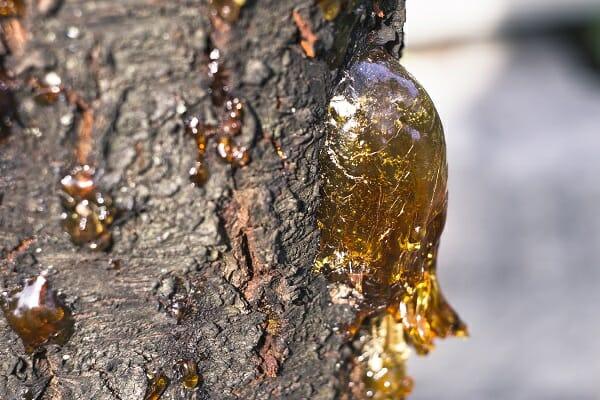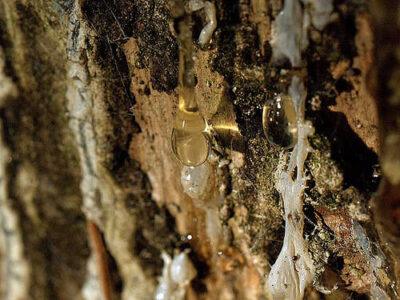Pine sap is a sticky substance secreted by pine trees in response to injury. It’s full of antimicrobial compounds to protect the tree’s wound from bacteria and fungi, and it’s naturally adhesive so that it stays put on a tree wound. It’s also a natural sealant, to prevent the tree from losing moisture through the wound.
All these qualities that make it a survival tool for the pine tree also make it very useful to human off-grid survival.
Pin sap (or resin) has been used by humans for centuries, for everything from medicine to construction. As far back as around the birth of Christ, there was a thriving pine resin trade, where sharecroppers would claim rights to pine trees to harvest their resin as a cash crop. Long before that, it was used by humans for survival and medicine.
Let’s examine ways it can be harvested and used.
Harvest
Pine sap is easy to harvest, and in many cases you’ll be able to find a fresh wound already dripping pitch. This is especially true near public parks, where the branches are frequently trimmed. To protect the tree, if possible only harvest pitch that has dripped away from the wound. The pitch directly on the wound surface is helping the tree fight infection, and harvesting this portion may damage the tree.
The Life-Saving Water Filter That Purifies River Water!
If you need to harvest pine sap in large quantity, intentionally creating “V”-shaped wounds in trees is the traditional method. Attach a small container at the tip of the “V” so that the pitch can run into it. It’ll be even more efficient if you cut a small bark tag at that point to help direct the sap into your collection container, much in the same way a maple tap directs maple sap into a bucket.
1. Sealant
Dissolved in alcohol, pine pitch is used as a natural wood varnish to help protect wood from the weather. It takes relatively strong alcohol to dissolve the pitch, so stick to grain alcohol or the highest proof you can find, ideally near pure 190 proof for varnish purposes if you can get it.
As pine sap is a natural tree wound protectant, it makes sense that it can be used to make a graft protectant by mixing it with a little beeswax and oil to improve the pliability and workability. Smear the mixture around graft cuts or pruning wounds to seal them and protect your trees.
Pine sap that has been heated to remove excess moisture is called pine tar, and it’s commonly used to make things water-tight. Boats and tents can be sealed with pine tar; just be sure you don’t heat the pine sap too hot as it can easily catch fire.
2. Medicine
Pine pitch is commonly used as a drawing agent to help draw foreign particles or poisons from a wound. Soft fresh drops can be harvested in the field and applied directly to spider bites or even splinters to help the body expel the poison or splinter. It’s known as a counter-irritant, helping signal the body to send more white blood cells to the site of an injury to fight infection. Pine pitch is also naturally antiseptic and antibacterial.
To store pine pitch for later use in your herbal first-aid kit, place a few globs of pitch in oil and leave it in a warm place for a few weeks, shaking regularly to help dissolve the pitch. Filter the oil through a cloth to strain out any remaining pitch pieces, and use the pine pitch oil as it is applied directly to wounds or add bees wax and form it into a medicinal salve.
3. Adhesive
Pine pitch glue is incredibly durable and was used traditionally for many purposes, such as attaching arrowheads to arrows along with sinew twine. It’s simple to make with almost no tools. Melt the pine pitch slowly on a stove or over a low fire, and then add finely crushed charcoal from the fire. The ratio of charcoal to pine sap varies, but a ratio of 3 parts sap to 1 part coal is a good starting point. The charcoal is what makes the glue durable and long-lasting, but be careful because too much charcoal will make the glue brittle.
4. Fire-starter
Pine sap is flammable and can be used as a fire-starting aid. A few dried gobs kept at hand can help a tinder bundle catch light in wet conditions, or melted sap can be used on a cloth on the end of a stick as a makeshift torch. Keep in mind that melted resin gets very hot, is quite sticky and drips easily, so handle with care to avoid causing serious burns.
What advice would you add on harvesting and using pine resin? Share your thoughts in the section below:
 Off The Grid News Better Ideas For Off The Grid Living
Off The Grid News Better Ideas For Off The Grid Living





